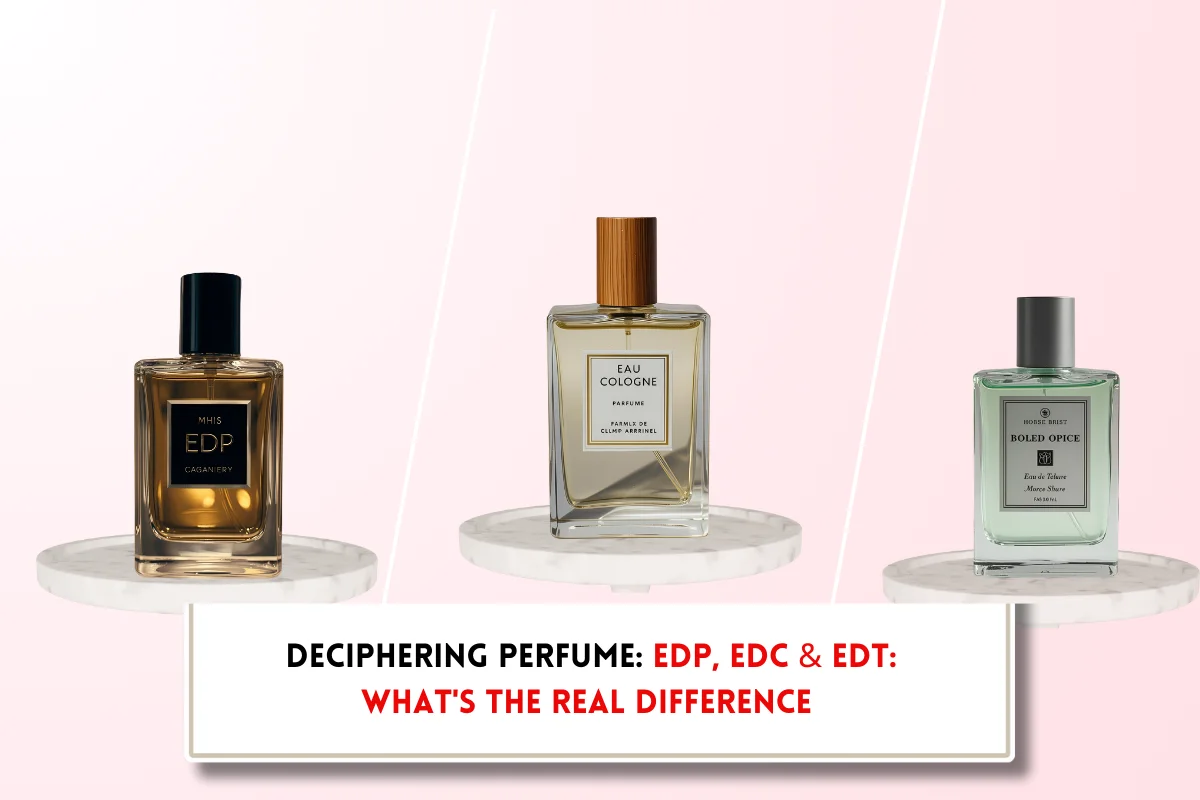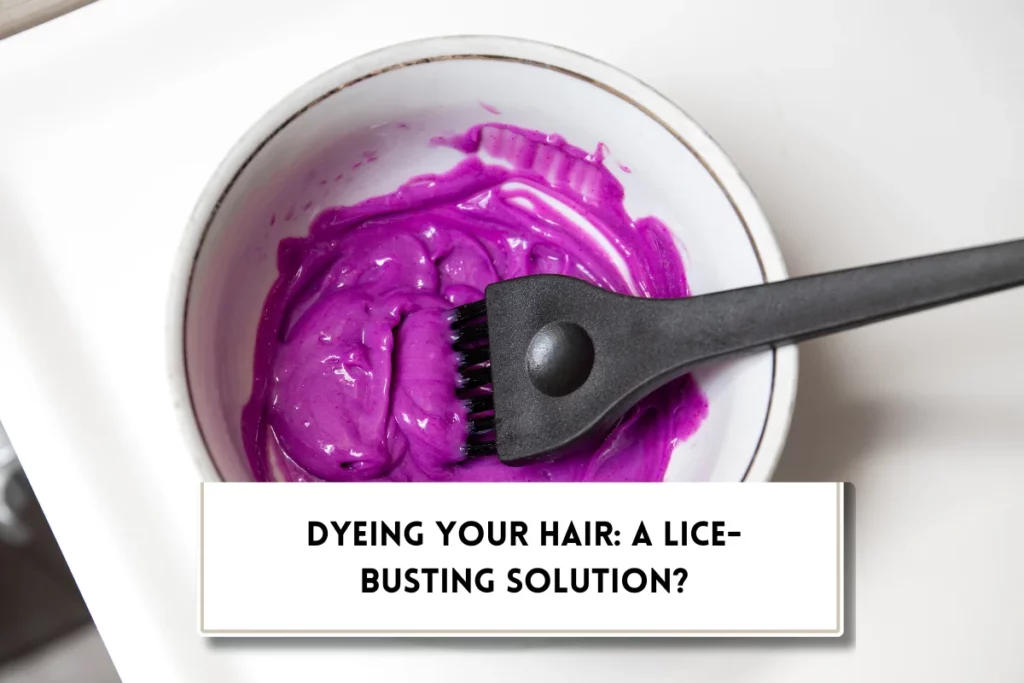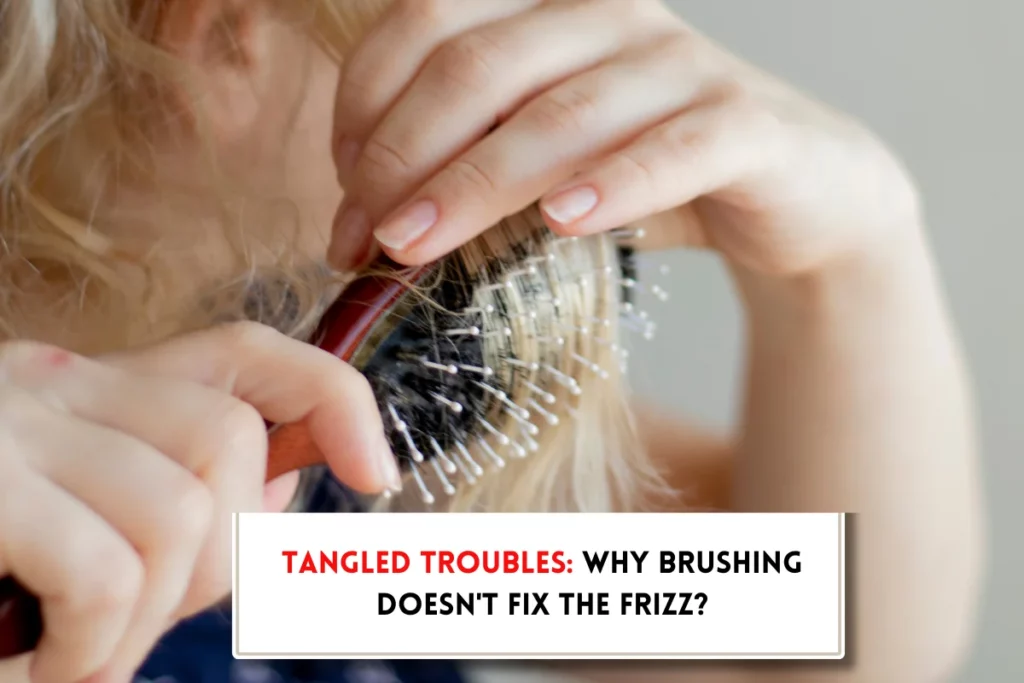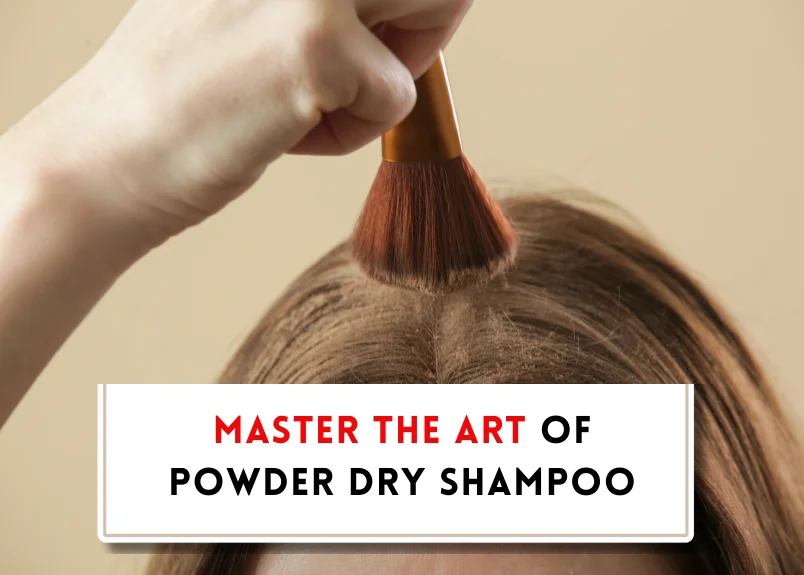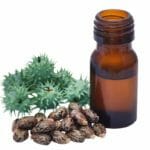Is a comb or brush better for thin hair?
At BeautyCaters, our expert team independently curates every recommended product. Purchases through our links may earn us a commission. Explore our transparent selection process.
Feeling like your thin locks are a bit lackluster? Here’s the deal: Thin hair is delicate and more prone to breakage. However the choice of the right tool, a comb or a brush can make a world of difference in its health and appearance. Wondering which is ideal, team comb or team brush? We’ll break down the MVP for your thin strands. So, get ready to find out is a comb or brush better for thin hair. No hair jargon needed.
- What is thin hair?
- Characteristics of thin hair
- What are the causes of thin hair?
- What are the problems with thin hair?
- The great debate: Is a comb or brush better for thin hair?
- Types of combs for thin hair
- What are the benefits of comb on thin hair?
- Types of brushes for thin hair
- Benefits of a brush for thin hair
- Comparison of combs and brushes
- Combs vs. Brushes: Key differences
- Common myths and facts
- What are the best practices for grooming thin hair?
- Tips for maintaining thin hair
- Expert recommendations
- Final Word: Is a comb or brush better for thin hair?
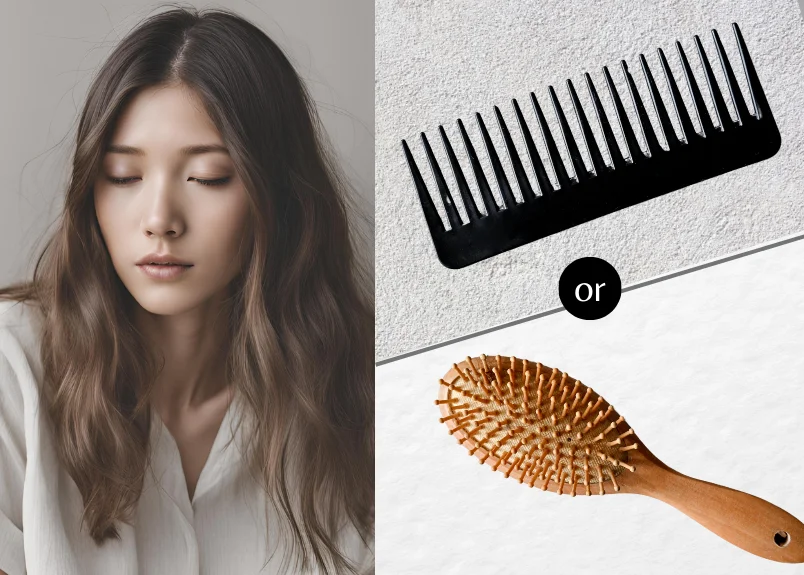
What is thin hair?
Thin hair is characterized by having a smaller diameter of individual strands, often resulting in a lack of volume and body. Unlike thicker hair types, thin hair requires specialized care and styling techniques to maintain its health and appearance.
Due to its delicate nature, thin hair is more prone to damage and breakage. It can also be more susceptible to frizz and tangling, especially in humid conditions. However, with the right care and attention, thin hair can be healthy, strong, and full of volume.
Characteristics of thin hair
Thin hair is characterized by having a smaller diameter of individual strands, often leading to a lack of volume and body. Unlike thicker hair types, thin hair requires specialized care and styling techniques to maintain its health and appearance. Key characteristics of thin hair include:
- Fine strands: Individual hair strands are thinner than those found in thicker hair types.
- Lack of volume: Thin hair often appears flat or lifeless, especially at the roots.
- Scalp visibility: Due to its reduced density, thin hair can make the scalp more visible.
- Increased breakage: Thin hair is more susceptible to breakage and damage.
- Greasiness: Thin hair can become oily more quickly than thicker hair types, often due to excess sebum production.
- Smaller strand diameter: Individual hair strands are thinner than those found in thicker hair types.
- Increased tangling: Due to its delicate nature, thin hair is more prone to tangling and knotting.
- Frizziness: Thin hair is often susceptible to frizz, especially in humid conditions.
A knowledge of these characteristics is essential for choosing the right products and tools to enhance the health and appearance of thin hair.
What are the causes of thin hair?
Thin hair can be caused by a variety of factors, including:
- Genetics: Hereditary factors play a significant role in determining hair thickness and density.
- Aging: As people age, their hair may naturally thin due to hormonal changes and a decrease in hair follicle activity.
- Medical conditions: Certain health conditions, such as thyroid disorders, autoimmune diseases, and hormonal imbalances, can lead to hair thinning.
- Stress: Prolonged stress can contribute to hair loss and damage.
- Poor diet: A lack of essential nutrients, like biotin or iron, can affect hair growth and density.
These underlying causes of thin hair help you identify potential solutions and take steps to improve its health and appearance.
What are the problems with thin hair?
Thin hair often presents several common challenges that can impact its appearance and manageability. These include:
- Breakage: Due to its delicate nature, thin hair is more susceptible to damage and breakage.
- Flatness: Thin hair often lacks volume and can appear limp, making it difficult to achieve desired styles.
- Oily scalp: Thin hair tends to become oily more quickly than thicker hair types, requiring more frequent washing.
- Hair loss: Thinning hair can lead to concerns about hair loss or even bald spots over time.
Addressing these common issues is essential for maintaining the health and appearance of thin hair.
The great debate: Is a comb or brush better for thin hair?
While there is no one-size-fits-all answer to this question, the debate over whether a comb or brush is better for thin hair has been ongoing for years. As someone with thin hair, I understand the struggle of finding the right tool to style and manage it effectively. Both combs and brushes have their pros and cons, and the choice ultimately depends on your hair type, texture, and personal preference.
Types of combs for thin hair
When it comes to styling and caring for thin hair, the right comb can make a significant difference. Here are some of the most popular types of combs and their benefits: Here’s a quick overview:
- Wide-toothed comb: A wide-toothed comb is ideal for detangling wet or dry hair without causing excessive breakage. It is particularly beneficial for individuals with curly or coarse hair, as it allows for gentle detangling without pulling or tugging.
- Fine-toothed comb: Fine-toothed combs are best suited for individuals with straight or fine hair. They are effective for creating precise partings and smoothing out the hair. However, it’s important to use a fine-toothed comb with caution, as excessive or aggressive combing can lead to hair breakage and damage.
- Wooden comb: Wooden combs, especially those with wide teeth, are known for their gentle and anti-static properties. They help distribute natural oils evenly through the hair, promoting moisture retention and overall hair health. Wooden combs are particularly suitable for those with sensitive scalps or prone to static electricity.
- Detangling brush: While not a traditional comb, a detangling brush with flexible bristles can be an excellent tool for minimizing hair loss, especially in children or individuals with very fine, easily tangled hair. The flexible bristles gently work through knots and tangles without causing excessive stress on the hair shaft.
The characteristics of different comb types, help you select the best tool to enhance the health and appearance of your thin hair.
What are the benefits of comb on thin hair?
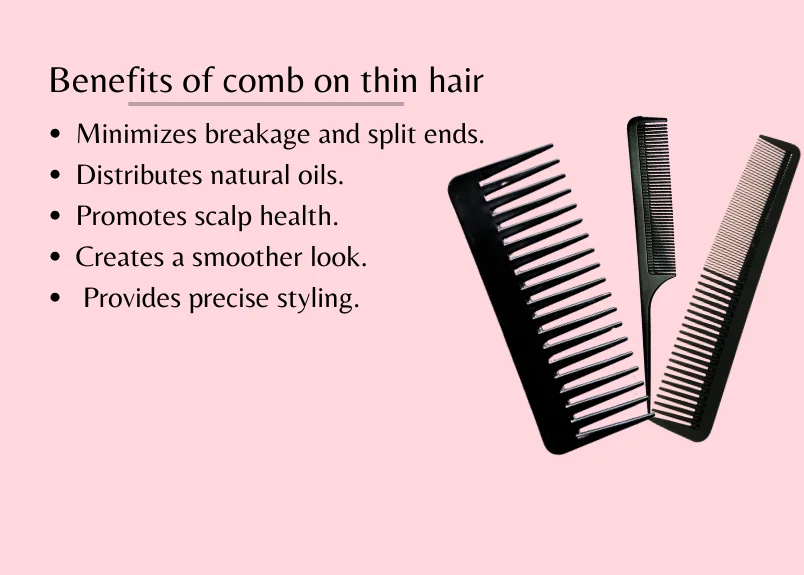
It’s imperative to understand the role that combs play in achieving the best results for your thin hair.
- Minimizes breakage and split ends: Combs are gentler on thin hair than brushes, reducing the risk of damage and preserving the integrity of your strands. This is particularly important for those with delicate hair that is prone to breakage.
- Provides precise styling: Combs offer greater control and precision compared to brushes, making them ideal for creating defined sections, smooth partings, and sleek hairstyles. This is especially beneficial for individuals with thin hair that can easily become tangled or unruly.
- Distributes natural oils: Combs help to evenly distribute the scalp’s natural oils throughout the hair, providing essential nutrients and promoting a healthy shine. This can help improve the overall appearance and condition of thin hair.
- Promotes scalp health: By gently removing debris, dead skin cells, and product buildup, combs can help keep your scalp clean and healthy. A healthy scalp is essential for promoting strong and healthy hair growth.
- Creates a smoother look: Combs are ideal for achieving a polished and sleek appearance, especially for hairstyles like low ponytails or updos. The precise control offered by combs can help create a smooth and polished finish.
In addition to these benefits, using a comb can also help to reduce frizz and static, which can be particularly problematic for thin hair. By choosing the right comb for your hair type and using it correctly, you can help to improve the overall health, appearance, and manageability of your thin hair.
Types of brushes for thin hair
While combs are often the preferred tool for styling thin hair, there are also various types of brushes that can be beneficial. Here’s a brief overview:
- Boar brush: Made with soft, flexible boar bristles, this brush is gentle on the scalp and helps seal the cuticles, promoting shine and movement.
- Porcupine brush: A combination of boar and nylon bristles, this brush provides a gentle yet firm hold for thin hair, adding volume and movement.
- Cushion brush: Featuring a rubber base to eliminate static, this brush is ideal for styling thin hair without causing damage.
- Round brush with a metal barrel: Perfect for blow-drying thin hair, this brush helps add volume, curl, and shine without the need for additional styling tools.
Selection of the right brush for your hair type and styling needs, you can help enhance the volume, health, and appearance of your thin hair.
Benefits of a brush for thin hair
Some may underestimate the role of brushes in managing thin hair, but they can actually be quite beneficial. Here are the 5 benefits of hair brush on thin hair.
- Stimulates scalp and promotes hair growth: Regular brushing can increase blood circulation to the scalp, which may help strengthen hair follicles and promote healthy hair growth.
- Prevents knots and tangles: Brushing can help detangle hair, reducing the risk of breakage and promoting a smoother finish.
- Enhances natural shine: Brushing distributes natural oils from the scalp throughout the hair, adding shine and improving overall hair health.
- Creates volume and body: Certain types of brushes can help lift thin hair at the roots, creating a fuller appearance.
- Reduces static and frizz: Using the right brush can help minimize static and frizz, which can be particularly problematic for thin hair.
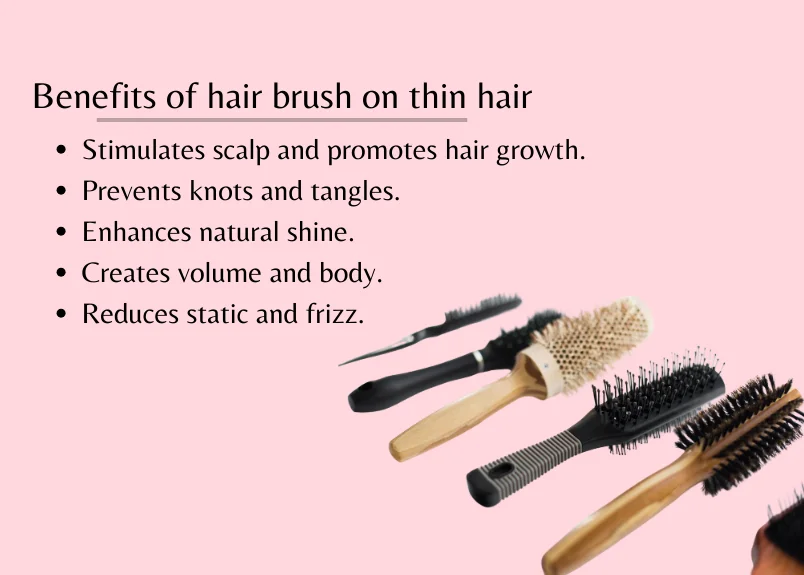
Comparison of combs and brushes
Not all tools are created equal when it comes to styling your hair, especially for those with thin hair. Both combs and brushes have their advantages and disadvantages. Below is a comparison to help you make the best choice for your needs.
Comparison Table
| Feature | Comb | Brush |
| Detangling | Excellent, especially wide-tooth combs | Varies by type, some are better than others. |
| Volume | Less effective at adding volume | Great for adding volume and smoothing |
| Styling | Good for precise styling and parting | Ideal for creating waves or curls |
| Static Control | May create static | Less likely to create static |
Combs vs. Brushes: Key differences
When it comes to styling thin hair, the choice between a comb and a brush significantly impact the results.
- Detangling: Combs, especially wide-toothed combs, are excellent for gently detangling thin hair, reducing the risk of breakage.
- Volume and smoothing: Brushes, particularly round brushes, are effective at adding volume and creating a smooth, polished look.
Choice of the right tool depends on your individual hair type, styling preferences, and desired results. For example, if your thin hair is prone to tangling, a wide-toothed comb may be the best option. However, if you prefer a sleek and voluminous style, a round brush could be more suitable.
Ultimately, the best way to determine which tool is right for you is to experiment and see what works best for your hair. Consider your personal preferences, styling goals, and the amount of time you want to invest in your hair care routine.
Common myths and facts
There are many myths surrounding thin hair, such as the belief that using a brush will cause more breakage. However, the fact is that using the right brush or comb can actually help to distribute natural oils and prevent breakage. It’s important to separate fact from fiction when it comes to caring for thin hair, as using the right tools and techniques can make a big difference in the overall health and appearance of your hair.
What are the best practices for grooming thin hair?
Grooming thin hair requires a gentle approach, careful grooming techniques and the use of suitable tools. These practices help maintain the integrity of your thin hair and ensure it looks its best. Here are some best practices:
- Comb usage:
- Opt for a wide-toothed comb: This helps prevent breakage and reduces damage to delicate strands.
- Start detangling from the ends: Work your way up to the roots to avoid excessive pulling.
- Be patient and gentle: Use gentle strokes to prevent breakage.
- Brushing techniques:
- Use a soft-bristled brush: Avoid using brushes with hard bristles that can damage thin hair.
- Start at the ends: Work your way up to the roots to minimize breakage.
- Be gentle: Avoid vigorous brushing, as it can lead to damage.
- Detangling practices:
- Use a wide-toothed comb or gentle brush: Choose tools specifically designed for thin hair.
- Start from the ends: Work your way up to avoid breakage.
- Apply leave-in conditioner: This can help soften the hair and make it easier to detangle.
These practices, you can help maintain the health and appearance of your thin hair.
Tips for maintaining thin hair
Beyond choosing the right tools, there are several additional steps you can take to promote the health and appearance of thin hair:
- Avoid harsh treatments: Minimize the use of harsh chemicals and excessive heat styling.
- Be gentle when styling: Avoid pulling or tugging on your hair.
- Use a volumizing shampoo: This can help add body and fullness to thin hair.
- Condition only the ends: Applying conditioner to the roots can weigh down thin hair.
- Limit heat styling: Embrace air drying whenever possible to reduce damage.
- Regular trims: This helps eliminate split ends and promote healthy hair growth.
- Protect from harsh weather: Shield your hair from sun, wind, and other environmental factors.
This holistic approach to hair care is essential for maintaining the health and appearance of thin hair.
Expert recommendations
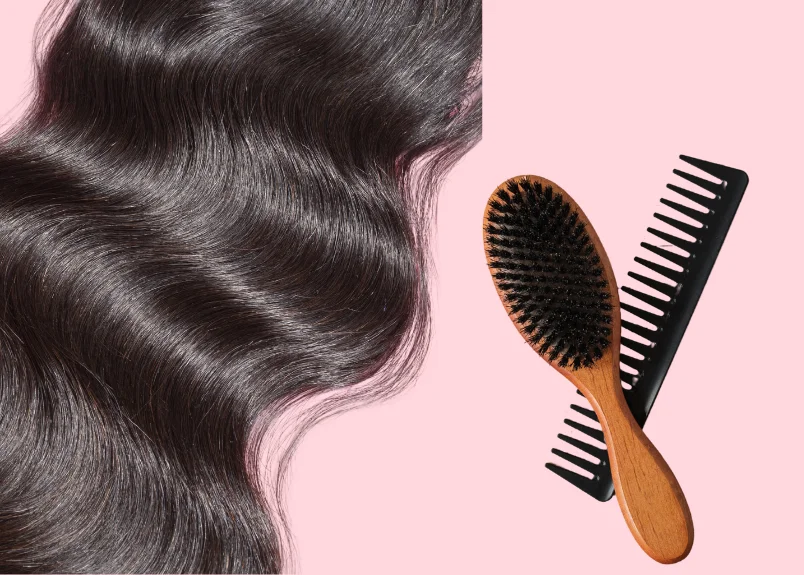
To achieve the best results for your thin hair, experts generally recommend using a wide-tooth comb. This tool helps to reduce breakage while detangling and works well on wet hair. For styling, opt for a boar bristle brush, which can distribute natural oils evenly and add shine without causing excessive friction. Your choice should depend on your hair’s current condition and your styling needs, so consider incorporating both tools into your routine for optimal care.
Stylist insights
The majority of stylists emphasize the importance of gentleness when caring for thin hair. They advise that you should always start at the ends of your hair when detangling to minimize pulling and breakage. Additionally, using a heat protectant before styling can safeguard your hair from damage. Choosing the right tools tailored to your hair type can significantly enhance its health and appearance.
User testimonials
Before trying a new comb or brush, many users have noted their concerns about hair breakage and tangles. Positive experiences often highlight the effectiveness of a wide-tooth comb for effortless detangling without causing stress to the strands. Likewise, others share how switching to a quality boar bristle brush improved their hair’s texture and reduced frizz, leaving their locks looking more vibrant.
This feedback not only underscores the importance of choosing the right tools, but it also illustrates how personal experience can guide you. Users report that experimenting with various combs and brushes helped them discover what works best for their unique hair type. Integrating these insights into your routine may help you enjoy healthier, more manageable hair day after day.
Final Word: Is a comb or brush better for thin hair?
So, which is better for thin hair: a comb or a brush? The answer is…it depends! Both tools have their unique advantages, and the best choice ultimately comes down to your personal preferences and hair type.
If you’re looking for a gentle detangling option, a wide-toothed comb is a great choice. For adding volume and creating defined styles, a round brush can be a valuable tool. Experiment with both to see which one works best for your hair.
Remember, the key to healthy, vibrant thin hair is a combination of gentle care, the right tools, and a healthy lifestyle. With a little attention, you can achieve the full, flowing hair you’ve always dreamed of.


